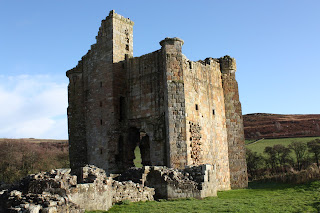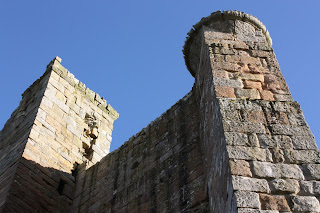The weather forecast was none too good as we initially set of for the village of Bothal, possibly often on the itinerary of birdwatchers because of the pool nearby. Our trip was in the main a none birding outing and because of the weather I was hoping maybe for some Turneresque skies to enhance some landscape photography. It was appropriate then, that our first stop was at Bothal as this was on J M W Turner’s schedule of visits on his tour of Northern England in 1797. Turner, the greatest of British artists in my view, was only twenty-two at the time. His sketches of Bothal, the castle and church remain very recognisable today, although the houses of today are a great deal more up-market and no doubt expensive. Turner depicts a horse and rider in the sketch of the castle, and coincidently a horse with rider came along the road today.
The castle, a private residence, has a long history and having taken some photographs of it we took a walk in the Church grounds where bird finds included several Nuthatches and Mistle Thrushes, both species calling loudly. The Mistle Thrush’s vernacular name of Storm Cock proved appropriate today, as you will later find.
Much of the
present church is between 600 and 800 years old. Inside, which because of Corvid we were
unable to enter, holds fragments of an Anglo-Saxon cross suggesting a much
earlier church on the site. Of course,
as to be expected there are Victorian additions. The doorway has a carved inscription reading WH
1578. We must return in the future
when access can be gained to see medieval stained glass, but we did take note
of the medieval stone coffins outside.
The graveyard was very natural and contained many trees of age. The war memorial outside the front of the
church is flanked by weeping Ash and Japanese Maple. The Ash representing the tears of the
bereaved and the Maple which turns bright red in autumn, symbolising the blood
of the fallen.
On route to
Swarland we passed Davison’s Obelisk built in 1807 in memory of Horatio Nelson
at the bequest of Alexander Davison, a friend of Horatio Nelson who he first
met at Quebec, Canada. Davison became
Prize Agent responsible for the sale of French ships taken at the Battle of the
Nile. At Swarland we looked over the Parkland
of what had been the estate of Alexander Davison who had planted groups of
trees to represent ships of the British Navy at The Battle of the Nile. Only four of these groups are now still
extant, one group being close to the road.
The line of the road represents the line of French Ships.
We next made north to Edlingham Church and Castle. The weather began to close in and on arrival at the small parking area by St John the Baptist Church, the rain became heavier until we were amidst a heavy squall. The sky became a mix of leaden grey cloud and mist as the light faded. We admired the church in these gloomy conditions whilst we chatted and ate lunch in the security of the car.
Once the
rain eased somewhat I decided to venture out and photograph the church. The gloominess did not appear to be
disappearing until suddenly there was signs the darkness lifting.
The earliest
church on this site dates to around 740AD, although the first stone church
dates to the 11th Century.
Fragments of this Saxon church can be found in the lintels of the
door. Much of the remainder is 12th
Century and the tower was added probably for defensive reasons around the early
14th Century. Narrow slit
windows could be used by archers. It is
thought that the church was used in the 17th Century to imprison
moss-troopers.
From the
church it is a short walk to the castle and the nearby burn, a tributary of the
River Aln, is close by.
I was extremely
impressed by both the church and castle, the latter’s Solar Tower being an
especially imposing site. My mind
retuned to Turner and I could not help feeling that the painter missed a trick in
not visiting this site on his trip north.
The tower dates from the 15th Century but other structures
are from an earlier date.
Our first
sighting of the castle at close range was in the dullness of the recently
ceased storm, but as time passed beams of light began to lighten up the outer
walls and it wasn’t long before light cloud was dissipating and we were under
cerulean skies. As we had approached
the castle the roosting Jackdaws had been disturbed and they appeared to
make a noisy retreat to trees nearby and did not return until we left. We’d had the remains of this imposing castle
all to ourselves and we had the privilege of viewing both castle and church in
varying moods and weather conditions. I
began to imagine the joys, celebrations, sadness and bloody violence this site had
witnessed over the centuries.
Deciding
that a visit to the nearby Viaduct can be made at a later date, we drove a
little way up the road for the views across the verdant fields toward The
Cheviots. As we took photographs a Common
Buzzard flew north of us as corvids mobbed it, and its mewing call seemed
to reflect a solemn mood.
We took a long detour on our return home and passed the road to Clennell Hall (the family home of Luke Clennell, an apprentice of Thomas Bewick and Bewick’s principal assistant on The History of British Birds). He later became an artist in his own right, moved to London, suffered mental illness and died in an asylum in Newcastle in 1840) and Alwinton. Along the way we had sightings of many Redwing and Fieldfare, and Kestrels. As we drove along the Coquet valley we followed the serpentine movement of the bright silvery river, now lit by bright sunlight. The day had certainly been one of multiple moods.
Addendum.
If willing to pay a not unsubstantial amount, Turner’s drawings and
paintings following his tour north can been seen in David Hill’s Turner in
the North. Possibly cheaper to
visit the Tate Gallery in London and see Turner’s paintings there. I’m pleased I purchased my copy years ago at
a reasonable price when first published!
Anyone who
reads this blog on a regular basis (I hope someone does), will know I
have fondness for the poetry of John Clare.
I have noted that Turner visited Stamford on his return journey south,
the town close by Clare’s village of Helpston.
Clare would have been four years of age at the time, so there will have
been no meeting of the two. However,
both I am sure would in later years have become very much aware of one another. John Clare was introduced as a boy to poetry
by James Thompson’s poem The Seasons.
His copy of the poem was purchased at Stamford I believe. It is interesting to note that Turner too was
inspired by the same poem. I must
research into whether the two men ever met when Clare made his short visits to
London in later years. The two men could
well have had much in common.



















No comments:
Post a Comment